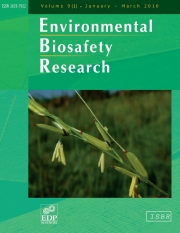Article contents
Transgenes and national boundaries –The need for international regulation
Published online by Cambridge University Press: 24 September 2009
Abstract
What happens when one nation cultivates a transgenic crop variety but neighboring nations do not? Using alfalfa as a case study, we argue that the potential for international transgene flow is substantial, and therefore, the need for international cooperation in regulatory decisions concerning transgenic crops is imperative. Alfalfa (Medicago sativa, L.) is the major forage crop in North America. Recently, genetically modified (GM) alfalfa received a moratorium on further cultivation in the US on the grounds that the approvals were based on inadequate environmental impact assessments. With their deep root system, symbiotic nitrogen fixation, prolific seed production and prolonged dormancy, alfalfa plants are capable of establishing self-perpetuating (feral) populations in unmanaged environments. Given what is known about alfalfa pollen dispersal, such feral populations could facilitate gene flow between GM and non-GM fields. The border between the US and Canada, particularly in farming areas, is very narrow (< 10 m wide). We surveyed along the US-Canada border and found both alfalfa fields and potentially feral alfalfa plants in the ditches along the border. Our survey results provide evidence of the possibility of cross-border transgene flow, suggesting a need for international co-operative risk assessment initiatives between the US and Canada. Such situations could occur for other crops, in other international border regions as well.
Information
- Type
- Research Article
- Information
- Copyright
- © ISBR, EDP Sciences, 2009
References
- 3
- Cited by

